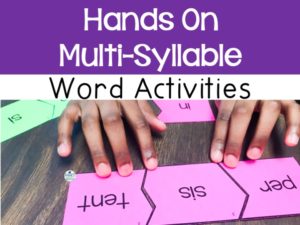There are so many ways to use interactive classroom anchor charts in the classroom. If you have devices, I’m going to share 7 ways to use them for various teaching scenarios.
Substitute Teacher
If you have a sub for the day, it can be tricky to make sure the kids still have a day filled with meaningful learning. Especially if you don’t know who the sub is.
If you want to maintain the learning momentum you had the day before, using interactive anchor charts is a great way to do that.

All you have to do is assign the charts on whatever platform you use to share assignments with students. And then just leave a note for the sub for that time period on what the kids are expected to do.
Kids can complete the interactive anchor charts and turn them in.
Absent Students
Kids will miss school for various reasons. By using interactive anchor charts with those kids, you can bridge the gap between what they missed and the lessons that follow.
Design interactive anchor charts that cover the most important topics for the year.

When a child is absent, assign them the interactive charts that cover the most important skill they missed.
Using these types of charts with absent kids, helps them stay connected and informed so they don’t fall too far behind.
Differentiation Made Easy
It’s always important to analyze where we can differentiate instruction for students.
Sometimes that means we allow kids to work at their own pace on a certain skill or topic. Or maybe they need to learn it more than one time in order to understand and retain it.
This is easy with interactive anchor charts.

You can assign the appropriate charts to individual students so they can learn at their own pace. Or assign them to kids that need extra review of the skill.
Kids can turn them in so the teacher can get feedback on whether or not mastery was achieved.
Whole Class Instruction
Anchor charts on paper have long been a staple in whole-class and small-group instruction.
If you have devices, using digital versions can help make lessons interactive and encourage participation during whole-group instruction.

As you teach a skill or concept, use interactive anchor charts that you display on the screen for the whole class.
The kids can follow along on their own version on their devices.
Another benefit of using them with the whole class is being able to reinforce tech skills like how to move an interactive piece or how to go to the next slide.
Math Centers or Math Stations
Whether you call them math centers or stations, interactive anchor charts can easily be incorporated.
You can use them solely as the center or station or as a reference tool for kids to use along with the center activity.

For example, just say you have a center activity with task cards that instruct kids to complete word problems on rounding.
At that center or station, you can set up a device with interactive anchor charts for rounding. When a child has difficulty with rounding while completing a task card, they can refer to and interact with the charts.
Group Collaboration
Promote collaboration and teamwork by involving kids in creating their own interactive anchor charts.
Create groups and assign them a topic or skill that they will teach by creating their own interactive classroom anchor charts.

After they complete the anchor charts each group can teach the skill and present their charts.
This is a great activity to do at the end of a unit because you can assign each group a topic or skill from the unit.
Independent Practice or Virtual Learning Days
If you have days where kids will be learning independently like on virtual learning days, having interactive classroomanchor charts is a great thing to have ready to go.
Some math and literacy skills are difficult to teach virtually.
If you have charts available for students that teach those difficult skills, you can ensure that kids get the content they need even if they’re not in class with you.

They also work as a supplement tool on virtual days to help kids when they are struggling with a skill or concept in another virtual assignment.
They can refer to the anchor chart, interact with it, and perhaps have a better understanding of the skill.
Whether it’s maintaining momentum with subs or bridging the gap for absent students, interactive classroom anchor charts are an amazing tool for teachers in so many situations.
Check out the resources highligted:
Interactive Anchor Charts for 3rd Grade Math & Prefixes and Suffixes
📌 Pin this Post to Save for Later





